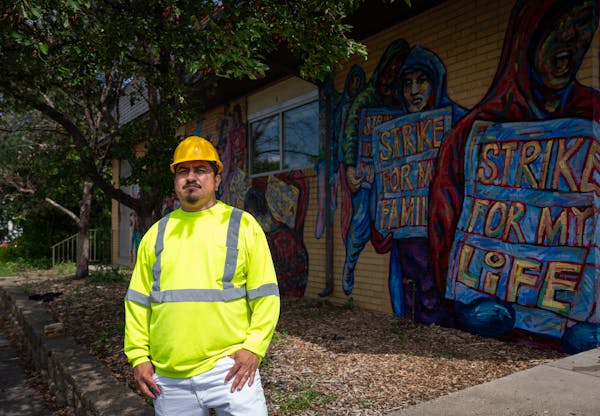Cub employee Judi Johnson will always remember the unmasked customer in a store who told her she'd tested positive for COVID-19 but just needed to get out of the house.
When Johnson voted for a first-ever strike at Cub earlier this year, troubling moments like that one were at the forefront of her mind as one of the often-overlooked front-line workers during the height of the pandemic.
"We stood our ground, and we were ready to picket and fight for what we believe is right," she said. "And at the last minute, they came in with an offer and, in my experience and in my long-term employment with Cub Foods, that's the best contract I've ever seen."
That energy around unions is spreading across the retail sector. Workers are in demand amid a labor shortage but often for jobs making relatively low wages with often unpredictable and sometimes involuntarily part-time hours. That's fostered a sense of having little to lose and more to gain by banding together for better pay, benefits and schedules.
In some cases — like the averted multi-day strike at Cub ahead of the Easter holiday — existing unions are becoming more aggressive and voting to walk out for the first time. The eventual Cub deal included average raises of $2.50 to $3.50 an hour starting next spring, and Cub spokesman Charles Davis said both sides also developed "a structure to have continuing conversations" about health concerns like what Johnson experienced.
But even at companies with progressive reputations — like Apple, Starbucks and Trader Joe's — workers around the country are organizing, even as many retailers offer benefits to eligible employees such as paid time off, retirement plans and health care coverage.
Complaints to the National Labor Relations Board are up significantly in Minnesota and nationally as union activity this year increased in almost every industry.
What's behind the retail labor movement: a workforce shortage that tilts power toward employees; front-line workers' frustration from facing rude customers during the pandemic while higher-ups worked from home; and a generally more favorable outlook on unions.
Many Americans continue to see the long-term decline in the share of union-represented workers as bad for both the country and working people, according to a Pew Research Center survey this year.
Historically, few retail workers unionized. The number of workers overall belonging to unions increased by 273,000 to 14.3 million in 2022 from the year before, according to the U.S. Bureau of Labor Statistics. But the rate was the lowest recorded, down to 10% last year, because of a disproportionately large overall increase in the number of (mostly nonunion) workers. The median hourly retail wage is $14.71.
Jeff Oveson — president of Teamsters Local 346, which represented 166 workers striking at Blandin Paper Mill in Grand Rapids until an agreement this month — called this a great time to be in organized labor because of high demand for workers.
"Employees out there everywhere should be looking to organize right now and to stand up for themselves," he said. "Don't get left behind in this labor market."
Brit Ramsland supported the effort to unionize at Seward Co-op five years ago and credits the union for subsequent raises.
"When I first started here and asked for an increase, my manager said, 'You're going to have to pray to Jesus,' " said Ramsland, who's on the United Food & Commercial Workers Local 663 bargaining committee for the next contract.
A Seward Co-op spokesperson said "the leadership works in good faith with the union to improve working wages and conditions for staff."
For the first time, four unionized Half Price Books in the Twin Cities are bargaining for a contract and held a two-day strike July 13-14.
After facing drastic cuts in hours in 2021 for a few months, losing health care coverage briefly and turning to plasma donations to make ends meet, Starbucks barista Kyle Esparza voted to unionize the St. Anthony location in March 2022.
"They really lead with the values, but they don't show it in any great way or benefit," he said of Starbucks.
In a response, Starbucks — which refers to its employees as partners — alleged "the union is driving a wedge between us, pitting partner against partner."
"We won't always get it right, but we show up every day to do right by every partner, just like we've done for partners over the past 52 years," the statement said. "That's why we're better when we're together."
Starbucks is the most notorious recent case of a company pushing back against unions. In one instance, Starbucks fired several employees — dubbed the Memphis Seven — after they held an in-store media interview about their organizing efforts. Last year, a federal judge ordered their reinstatement, and the company had a recent appeal rejected.
This year, workers from Cub corporate stores, Lunds & Byerlys and Kowalski's Markets — which United Food & Commercial Workers Local 663 represent — nearly went on strike alleging unfair labor practices before eventually coming to contract agreement. Kowalski's also filed an unfair labor practice charge against the union but dropped it after reaching a deal.
Roy Bahat, a venture capitalist who convenes the Aspen Business Roundtable on Organized Labor, believes many executives hold stereotypes about unions from other eras.
"One thing I strongly believe is if you have two parties in a relationship, it only takes one party who thinks it's a fight to have a fight," he said.
Instead, he advises companies not to take unions personally and to develop a collaborative relationship.
"I'm not out there to say unions are good or bad," Bahat said. "I'm out there to say, 'Things can go well or poorly, depending on how CEOs handle it.'"
Given this backdrop John Budd, professor of work and organizations in the University of Minnesota's Carlson School of Management, sounds this warning to hopeful new union members.
"If you look at Starbucks, lots of stores have organized, but there's no contract," he said. "So it's a long, arduous road."
Star Tribune staff writer Dee DePass contributed to this report.

Bushel Boy, Minnesota's local tomato grower, sold
After 60 years, federal cuts shutting down Job Corps center in St. Paul

In a first, Minnesota doctors walk their own picket line, then hustle to see patients
It's harder to find a job this year, especially a corporate position



